
Battle of Gettysburg, Third Day cavalry battles
Encyclopedia
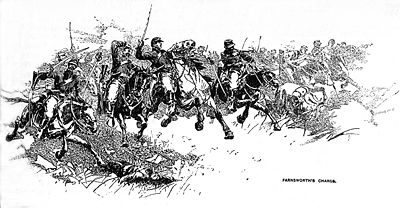
Battle of Gettysburg
The Battle of Gettysburg , was fought July 1–3, 1863, in and around the town of Gettysburg, Pennsylvania. The battle with the largest number of casualties in the American Civil War, it is often described as the war's turning point. Union Maj. Gen. George Gordon Meade's Army of the Potomac...
(July 3, 1863) has focused on the disastrous infantry assault nicknamed Pickett's Charge
Pickett's Charge
Pickett's Charge was an infantry assault ordered by Confederate Gen. Robert E. Lee against Maj. Gen. George G. Meade's Union positions on Cemetery Ridge on July 3, 1863, the last day of the Battle of Gettysburg during the American Civil War. Its futility was predicted by the charge's commander,...
. During and after that charge, however, two significant cavalry battles also occurred: one approximately three miles (5 km) to the east, in the area known today as East Cavalry Field, the other southwest of the [Big] Round Top
Big Round Top
Big Round Top is a boulder-strewn hill notable as the topographic high point of the Gettysburg Battlefield and for 1863 American Civil War engagements for which Medals of Honor were awarded...
mountain (sometimes called South Cavalry Field).
The East Cavalry Field fighting was an attempt by Maj. Gen. J.E.B. Stuart
J.E.B. Stuart
James Ewell Brown "Jeb" Stuart was a U.S. Army officer from Virginia and a Confederate States Army general during the American Civil War. He was known to his friends as "Jeb", from the initials of his given names. Stuart was a cavalry commander known for his mastery of reconnaissance and the use...
's Confederate
Confederate States Army
The Confederate States Army was the army of the Confederate States of America while the Confederacy existed during the American Civil War. On February 8, 1861, delegates from the seven Deep South states which had already declared their secession from the United States of America adopted the...
cavalry to get into the Federal rear and exploit any success that Pickett's Charge may have generated. Union
Union Army
The Union Army was the land force that fought for the Union during the American Civil War. It was also known as the Federal Army, the U.S. Army, the Northern Army and the National Army...
cavalry under Brig. Gens.
Brigadier general (United States)
A brigadier general in the United States Army, Air Force, and Marine Corps, is a one-star general officer, with the pay grade of O-7. Brigadier general ranks above a colonel and below major general. Brigadier general is equivalent to the rank of rear admiral in the other uniformed...
David McM. Gregg and George Armstrong Custer
George Armstrong Custer
George Armstrong Custer was a United States Army officer and cavalry commander in the American Civil War and the Indian Wars. Raised in Michigan and Ohio, Custer was admitted to West Point in 1858, where he graduated last in his class...
repulsed the Confederate advances.
In South Cavalry Field, after Pickett's Charge had been defeated, reckless cavalry charges against the right flank of the Confederate Army, ordered by Brig. Gen. Judson Kilpatrick, were easily repulsed, resulting in the death of Brig. Gen. Elon J. Farnsworth
Elon J. Farnsworth
Elon John Farnsworth was a Union Army cavalry general in the American Civil War, killed at the Battle of Gettysburg.-Early life and career:...
.
Background and cavalry forces
Cavalry forces played a significant role at Gettysburg only on the first and third days of the battle. On the first day (July 1, 1863), the Union cavalry division of Brig. Gen. John BufordJohn Buford
John Buford, Jr. was a Union cavalry officer during the American Civil War, with a prominent role at the start of the Battle of Gettysburg.-Early years:...
successfully delayed the Confederate infantry forces under Maj. Gen. Henry Heth
Henry Heth
Henry "Harry" Heth was a career United States Army officer and a Confederate general in the American Civil War. He is best remembered for inadvertently precipitating the Battle of Gettysburg, when he sent some of his troops of the Army of Northern Virginia to the small Pennsylvania village,...
until Union infantry could arrive on the battlefield. By the end of the day, Buford's troopers had retired from the field.
On the Confederate side, most of Maj. Gen. Stuart's cavalry division was absent from the battlefield until late on the second day. Possibly misunderstanding orders from General Robert E. Lee
Robert E. Lee
Robert Edward Lee was a career military officer who is best known for having commanded the Confederate Army of Northern Virginia in the American Civil War....
, Stuart had taken his three best brigades of cavalry on a pointless ride around the right flank of the Union Army of the Potomac
Army of the Potomac
The Army of the Potomac was the major Union Army in the Eastern Theater of the American Civil War.-History:The Army of the Potomac was created in 1861, but was then only the size of a corps . Its nucleus was called the Army of Northeastern Virginia, under Brig. Gen...
and was out of touch with the main body of Lee's Army of Northern Virginia
Army of Northern Virginia
The Army of Northern Virginia was the primary military force of the Confederate States of America in the Eastern Theater of the American Civil War, as well as the primary command structure of the Department of Northern Virginia. It was most often arrayed against the Union Army of the Potomac...
since June 24, depriving Lee of critical intelligence information and of screening services. Stuart arrived from Carlisle
Carlisle, Pennsylvania
Carlisle is a borough in and the county seat of Cumberland County, Pennsylvania, United States. The name is traditionally pronounced with emphasis on the second syllable. Carlisle is located within the Cumberland Valley, a highly productive agricultural region. As of the 2010 census, the borough...
at General Lee's headquarters shortly after noon on July 2, and his exhausted brigades arrived that evening, too late to affect the planning or execution of the second day's battle. Hampton's Brigade camped to the north, following the relatively minor clash with Union cavalry at Hunterstown
Battle of Hunterstown
The Battle of Hunterstown was a minor cavalry engagement in Adams County, Pennsylvania, on July 2, 1863, during the Gettysburg Campaign of the American Civil War...
that afternoon.
Lee's orders for Stuart were to prepare for operations on July 3 in support of the Confederate infantry assault against the center of the Union line on Cemetery Ridge. Stuart was to protect the Confederate left flank and attempt to move around the Union right flank and into the enemy's rear. If Stuart's forces could proceed south from the York Pike along the Low Dutch Road, they would soon reach the Baltimore Pike, which was the main avenue of communications for the Army of the Potomac, and they could launch devastating and demoralizing attacks against the Union rear, capitalizing on the confusion from the assault (Pickett's Charge) that Lee planned for the Union center.
Confederate cavalry forces under Stuart for this operation consisted of the three brigades he had taken on his ride around the Union Army (commanded by Brig. Gen. Wade Hampton
Wade Hampton III
Wade Hampton III was a Confederate cavalry leader during the American Civil War and afterward a politician from South Carolina, serving as its 77th Governor and as a U.S...
, Brig. Gen. Fitzhugh Lee
Fitzhugh Lee
Fitzhugh Lee , nephew of Robert E. Lee, was a Confederate cavalry general in the American Civil War, the 40th Governor of Virginia, diplomat, and United States Army general in the Spanish-American War.-Early life:...
, and Colonel
Colonel (United States)
In the United States Army, Air Force, and Marine Corps, colonel is a senior field grade military officer rank just above the rank of lieutenant colonel and just below the rank of brigadier general...
John Chambliss) and the brigade of Col. Albert G. Jenkins
Albert G. Jenkins
Albert Gallatin Jenkins was an attorney, planter, representative to the United States Congress and First Confederate Congress, and a Confederate brigadier general during the American Civil War...
(under the command of Col. Milton J. Ferguson following Jenkins's wounding on July 2). Although these four brigades should have amounted to approximately 5,000 troopers, it is likely that only 3,430 men and 13 guns saw action that day. And following their nine-day ride around Maryland and Pennsylvania, they and their horses were weary and not in prime condition for battle.
Union cavalry forces were from the corps of Maj. Gen.
Major general (United States)
In the United States Army, United States Marine Corps, and United States Air Force, major general is a two-star general-officer rank, with the pay grade of O-8. Major general ranks above brigadier general and below lieutenant general...
Alfred Pleasonton
Alfred Pleasonton
Alfred Pleasonton was a United States Army officer and General of Union cavalry during the American Civil War. He commanded the Cavalry Corps of the Army of the Potomac during the Gettysburg Campaign, including the largest predominantly cavalry battle of the war, Brandy Station...
, who did not participate directly in the command of any cavalry actions during the Battle of Gettysburg. Since most of Buford's division had retired to Westminster, Maryland
Westminster, Maryland
Westminster is a city in northern Maryland, United States. It is the seat of Carroll County. The city's population was 18,590 at the 2010 census. Westminster is an outlying community within the Baltimore-Towson, MD MSA, which is part of a greater Washington-Baltimore-Northern Virginia, DC-MD-VA-WV...
(with the exception of his reserve brigade under Brig. Gen. Wesley Merritt
Wesley Merritt
Wesley Merritt was a general in the United States Army during the American Civil War and the Spanish-American War. He is noted for distinguished service in the cavalry.-Early life:...
, which was deployed directly south of Gettysburg), only two divisions were ready for action. Stationed near the intersection of the Hanover Road and the Low Dutch Road—directly on Stuart's path—was the division of Brig. Gen. David McM. Gregg. Gregg had two brigades present at Gettysburg, under Col. John B. McIntosh
John Baillie McIntosh
John Baillie McIntosh , although born in Florida, served as a Union Army brigadier general in the American Civil War. His brother, James M...
and Col. J. Irvin Gregg (David Gregg's cousin), but the latter was stationed on the Baltimore Pike. Irvin Gregg's one-brigade command was supplemented by the newly formed "Michigan Brigade
Michigan Brigade
The Michigan Brigade, sometimes called the Wolverines, the Michigan Cavalry Brigade or Custer's Brigade, was a brigade of cavalry in the volunteer Union Army during the latter half of the American Civil War...
" of Brig. Gen. George Armstrong Custer
George Armstrong Custer
George Armstrong Custer was a United States Army officer and cavalry commander in the American Civil War and the Indian Wars. Raised in Michigan and Ohio, Custer was admitted to West Point in 1858, where he graduated last in his class...
. Custer was assigned to the division of Brig. Gen. Judson Kilpatrick but happened to be on loan to David Gregg and requested permission from Gregg to join his fight. Altogether, 3,250 Union troopers opposed Stuart. The other brigade from Kilpatrick's division, commanded by Brig. Gen. Elon J. Farnsworth, was stationed to the southwest of the Round Top mountain, the area now known informally as South Cavalry Field.
East Cavalry Field
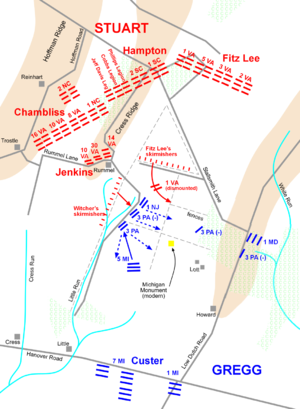
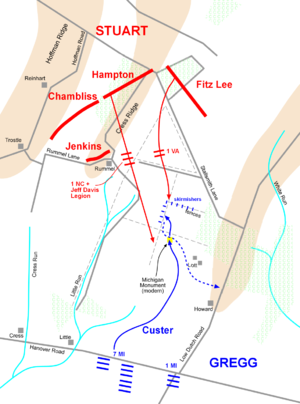
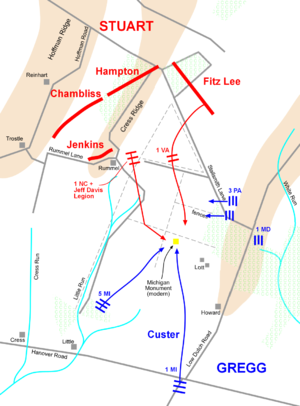
Stuart's plan had been to pin down McIntosh's and Custer's skirmishers around the Rummel farm and swing over Cress Ridge, around the left flank of the defenders, but the Federal skirmish line pushed back tenaciously; the troopers from the 5th Michigan Cavalry
5th Michigan Volunteer Cavalry Regiment
The 5th Regiment Michigan Volunteer Cavalry was a cavalry regiment that served in the Union Army during the American Civil War. It was a part of the famed Michigan Brigade, commanded for a time by Brigadier General George Armstrong Custer.-Service:...
were armed with Spencer repeating rifle
Spencer repeating rifle
The Spencer repeating rifle was a manually operated lever-action, repeating rifle fed from a tube magazine with cartridges. It was adopted by the Union Army, especially by the cavalry, during the American Civil War, but did not replace the standard issue muzzle-loading rifled muskets in use at the...
s, multiplying their firepower. Stuart decided on a direct cavalry charge to break their resistance. He ordered an assault by the 1st Virginia Cavalry
1st Virginia Cavalry
The 1st Virginia Volunteer Cavalry Regiment was a cavalry regiment raised in Virginia for service in the Confederate States Army during the American Civil War...
, his own old regiment, now in Fitz Lee's brigade. The battle started in earnest at approximately 1 p.m., at the same time that Col. Edward Porter Alexander
Edward Porter Alexander
Edward Porter Alexander was an engineer, an officer in the U.S. Army, a Confederate general in the American Civil War, and later a railroad executive, planter, and author....
's Confederate artillery barrage opened up on Cemetery Ridge
Cemetery Ridge
Cemetery Ridge is a geographic feature in Gettysburg National Military Park south of the town of Gettysburg, Pennsylvania, that figured prominently in the Battle of Gettysburg, July 1 to July 3, 1863. It formed a primary defensive position for the Union Army during the battle, roughly the center of...
. Fitz Lee's troopers came pouring through the farm of John Rummel, scattering the Union skirmish line.
Gregg ordered Custer to counterattack with the 7th Michigan
7th Michigan Volunteer Cavalry Regiment
The 7th Regiment Michigan Volunteer Cavalry was an cavalry regiment that served in the Union Army during the American Civil War. It was a part of the famed Michigan Brigade, commanded for a time by Brigadier General George Armstrong Custer.-Service:...
. Custer personally led the regiment, shouting "Come on, you Wolverines!" Waves of horsemen collided in furious fighting along the fence line on Rummel's farm. Seven hundred men fought at point-blank range across the fence with carbines, pistols, and sabers. Custer's horse was shot out from under him, and he commandeered a bugler's horse. Eventually enough of Custer's men were amassed to break down the fence, and they caused the Virginians to retreat. Stuart sent in reinforcements from all three of his brigades: the 9th and 13th Virginia (Chambliss's Brigade), the 1st North Carolina and Jeff Davis Legion (Hampton's), and squadrons from the 2nd Virginia (Lee's). Custer's pursuit was broken, and the 7th Michigan fell back in a disorderly retreat.
Stuart tried again for a breakthrough by sending in the bulk of Wade Hampton's brigade, accelerating in formation from a walk to a gallop, sabers flashing, calling forth "murmurs of admiration" from their Union targets. Union horse artillery batteries
U.S. Horse Artillery Brigade
The Horse Artillery Brigade of the Army of the Potomac was a brigade of various batteries of horse artillery during the American Civil War.Made up almost entirely of individual, company-strength batteries from the Regular Army’s five artillery regiments, the Horse Artillery operated under the...
attempted to block the advance with shell and canister, but the Confederates moved too quickly and were able to fill in for lost men, maintaining their momentum. Once again the cry "Come on, you Wolverines!" was heard as Custer and Col. Charles H. Town led the 1st Michigan Cavalry
1st Michigan Volunteer Cavalry Regiment
The 1st Regiment Michigan Volunteer Cavalry was a cavalry regiment that served in the Union Army during the American Civil War. It was a part of the famed Michigan Brigade, commanded for a time by Brigadier General George Armstrong Custer.-Service:...
into the fray, also at a gallop. A trooper from one of Gregg's Pennsylvania regiments observed,
As the horsemen fought desperately in the center, McIntosh personally led his brigade against Hampton's right flank and the 3rd Pennsylvania and 1st New Jersey hit Hampton's left from north of the Lott house. Hampton received a serious saber wound to the head; Custer lost his second horse of the day. Assaulted from three sides, the Confederates withdrew. The Union troopers were in no condition to pursue beyond the Rummel farmhouse.
The losses from the 40 intense minutes of fighting on East Cavalry Field were relatively minor: 254 Union casualties, 219 of them from Custer's brigade; 181 Confederate. Although tactically inconclusive, the battle was a strategic loss for Stuart and Robert E. Lee, whose plans to drive into the Union rear were foiled.
South Cavalry Field
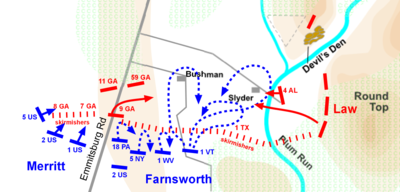
Alfred Pleasonton
Alfred Pleasonton was a United States Army officer and General of Union cavalry during the American Civil War. He commanded the Cavalry Corps of the Army of the Potomac during the Gettysburg Campaign, including the largest predominantly cavalry battle of the war, Brandy Station...
ordered two of his brigades to the left flank of the Union army. He ordered Brig. Gen. Wesley Merritt
Wesley Merritt
Wesley Merritt was a general in the United States Army during the American Civil War and the Spanish-American War. He is noted for distinguished service in the cavalry.-Early life:...
's Reserve Brigade of Buford's division to move north from Emmitsburg to join Brig. Gen. Judson Kilpatrick's division, moving from Two Taverns on the Baltimore Pike to the area southwest of Round Top
Big Round Top
Big Round Top is a boulder-strewn hill notable as the topographic high point of the Gettysburg Battlefield and for 1863 American Civil War engagements for which Medals of Honor were awarded...
. By this time, the only brigade in Kilpatrick's division was that of Brig. Gen. Elon J. Farnsworth
Elon J. Farnsworth
Elon John Farnsworth was a Union Army cavalry general in the American Civil War, killed at the Battle of Gettysburg.-Early life and career:...
, George Custer's brigade having been detached for service with David Gregg at East Cavalry Field. It is unclear what Pleasonton hoped to accomplish. There is no record that he performed any reconnaissance in this area. It has been speculated that Army of the Potomac commander George G. Meade was preparing for a possible counterattack to follow the repulse of Pickett's Charge, which he had anticipated since the night before.
Farnsworth reached the area at approximately 1 p.m., about the time the massive Confederate artillery barrage started in preparation for Pickett's Charge, and his 1,925 troops took up a position in a line south of the George Bushman farm. From left to right, the regiments were the 18th Pennsylvania Cavalry, the 1st West Virginia, and 1st Vermont. Battery E., 4th U.S. Artillery, occupied a small, rocky knoll in the rear and the 5th New York cavalry was placed in a nearby ravine to guard the artillery. Joined by Kilpatrick, they awaited Merritt's brigade, which arrived at about 3 p.m. and took up a position straddling the Emmitsburg Road, to Farnsworth's left. By this time the infantry portion of Pickett's Charge had begun, and Kilpatrick was eager to get his men into the fight.
On the Confederate line to the east of the Emmitsburg Road, only infantry troops were involved. The four brigades of Hood's division, under the command of Brig. Gen. Evander M. Law
Evander M. Law
Evander McIver Law was an author, teacher, and a Confederate general in the American Civil War.-Early life:...
, had occupied the area from Round Top, through Devil's Den
Devil's Den
Devils Den is a boulder-strewn Gettysburg Battlefield hill used by artillery and infantry during the 1863 Battle of Gettysburg, Second Day...
, and back to the road since the battle on July 2. Initially, Law had just the 1st Texas Infantry (from Brig. Gen. Jerome B. Robertson
Jerome B. Robertson
Jerome Bonaparte Robertson was a doctor, Indian fighter, Texas politician, and a general in the Confederate States Army during the American Civil War...
's Texas Brigade
Texas Brigade
The Texas Brigade, also often referred to as Hood's Brigade, was an infantry brigade in the Confederate States Army that distinguished itself for its fierce tenacity and fighting capability during the American Civil War.-Organization:...
) facing Farnsworth to the south, but he soon reinforced them with 47th Alabama Infantry, the 1st South Carolina, and artillery. To the west of the road, facing Merritt, was the Georgia brigade of Brig. Gen. George "Tige" Anderson
George T. Anderson
George Thomas Anderson was a general in the Confederate States Army during the American Civil War. Nicknamed "Tige," Anderson was noted as one of Robert E...
.
Young Kilpatrick had little experience in commanding cavalry, and he demonstrated that by attacking fortified infantry positions in a piecemeal fashion. West of the road, Merritt went in first, with his 6th Pennsylvania cavalrymen fighting dismounted. Anderson's Georgians repulsed their attack easily. Farnsworth was to follow, but he was astonished to hear Kilpatrick's order for a mounted cavalry charge. The Confederate defenders were positioned behind a stone fence with wooden fence rails piled high above it, too high for horses to jump, which would require the attackers to dismount under fire and dismantle the fence. The terrain leading to it was broken, undulating ground, with large boulders, fences, and woodlots, making it unsuitable for a cavalry charge. Accounts differ as to the details of the argument between Farnsworth and Kilpatrick, but it is generally believed that Kilpatrick dared or shamed Farnsworth into making the charge the latter knew would be suicidal. Farnsworth allegedly said "General, if you order the charge I will lead it, but you must take the awful responsibility."
First in the assault was the 1st West Virginia Cavalry, led by Colonel Nathaniel P. Richmond. They rode in great confusion after coming under heavy fire from the 1st Texas, but they were able to breach the wall. Hand-to-hand fighting with sabers, rifles, and even rocks ensued, but the attack was forced back. Of the 400 Federal cavalrymen in the attack, there were 98 casualties. The second wave came from the 18th Pennsylvania, supported by companies of the 5th New York, but they were also turned back under heavy rifle fire, with 20 casualties.
It was finally the turn of the 1st Vermont Cavalry, about 400 officers and men, which Farnsworth divided into three battalions of four companies each under Lieutenant Colonel Addison W. Preston, Major William Wells
William Wells (general)
-Medal of Honor:Wells commanded the Second Battalion, 1st Vermont Cavalry, in the repulse of Stuart's Cavalry at the Battle of Hanover during the Gettysburg Campaign...
, and Captain Henry C. Parsons. Parsons's battalion led the charge, passing the Texans and riding north into the blinding sun toward the John Slyder farm. Evander Law sent three Georgia regiments (the 9th, 11th, and 59th) to move to the support of the Texans and the artillery batteries. A staff officer carrying the order encountered the 4th Alabama, who also joined in support. An Alabama lieutenant yelled "Cavalry, boys, cavalry! This is no fight, only a frolic, give it to them!" And the infantrymen found many easy targets.
All three battalion advances were turned back with great losses. The final group, led by Wells and by Farnsworth, circled back toward Big Round Top, where they met a line of the 15th Alabama across their front. Farnsworth's party had dwindled to only 10 troopers as they weaved back and forth, trying to avoid the murderous fire. Farnsworth fell from his horse, struck in the chest, abdomen, and leg by five bullets. Postwar accounts by a Confederate soldier that claimed Farnsworth committed suicide with his pistol to avoid capture have been discounted. Major Wells received the Medal of Honor
Medal of Honor
The Medal of Honor is the highest military decoration awarded by the United States government. It is bestowed by the President, in the name of Congress, upon members of the United States Armed Forces who distinguish themselves through "conspicuous gallantry and intrepidity at the risk of his or her...
for his heroism in leading the rest of his men back to safety. The Vermont regiment suffered 65 casualties during the futile assault.
Kilpatrick's ill-considered and poorly executed cavalry charges are remembered as a low point in the history of the U.S. Cavalry and marked the final significant hostilities at the Battle of Gettysburg. Six miles (10 km) west of Gettysburg, one of Merritt's regiments, the 6th U.S. Cavalry, was defeated that afternoon at Fairfield
Battle of Fairfield
The Battle of Fairfield was a cavalry engagement during the Gettysburg Campaign of the American Civil War. It was fought July 3, 1863, near Fairfield, Pennsylvania, concurrently with the Battle of Gettysburg, although it was not a formal part of that battle...
by Brig. Gen. William E. "Grumble" Jones
William E. Jones
William Edmondson Jones, known as Grumble Jones, was a planter, a career United States Army officer, and a Confederate cavalry general, killed in the Battle of Piedmont in the American Civil War.-Early life:...
's "Laurel Brigade," an action not considered to be a formal part of the Battle of Gettysburg, but one that had a critical role in the retreat of Lee's army
Retreat from Gettysburg
The Confederate Army of Northern Virginia began its Retreat from Gettysburg on July 4, 1863. Following General Robert E. Lee's failure to defeat the Union Army at the Battle of Gettysburg , he ordered a retreat through Maryland and over the Potomac River to relative safety in Virginia. The Union...
.
All of Pleasonton's cavalry brigades were exercised for the remainder of the Gettysburg Campaign
Gettysburg Campaign
The Gettysburg Campaign was a series of battles fought in June and July 1863, during the American Civil War. After his victory in the Battle of Chancellorsville, Confederate General Robert E. Lee's Army of Northern Virginia moved north for offensive operations in Maryland and Pennsylvania. The...
in the lackluster pursuit of Lee's army back across the Potomac River
Potomac River
The Potomac River flows into the Chesapeake Bay, located along the mid-Atlantic coast of the United States. The river is approximately long, with a drainage area of about 14,700 square miles...
.
Further reading
- Ballard, Ted, and Billy Arthur. Gettysburg Staff Ride Briefing Book. Carlisle, PA: United States Army Center of Military History, 1999. .
- Bearss, Edwin C.Ed BearssEdwin Cole Bearss , a United States Marine Corps veteran of World War II, is a military historian and author known for his work on the American Civil War and World War II eras and is a popular tour guide of historic battlefields...
Fields of Honor: Pivotal Battles of the Civil War. Washington, DC: National Geographic Society, 2006. ISBN 0-7922-7568-3. - Bearss, Edwin C. Receding Tide: Vicksburg and Gettysburg: The Campaigns That Changed the Civil War. Washington, DC: National Geographic Society, 2010. ISBN 978-1-4262-0510-1.
- Carhart, Tom. Lost Triumph: Lee's Real Plan at Gettysburg—And Why It Failed. New York: G. P. Putnam's Sons, 2005. ISBN 978-0-399-15249-8.
- Gottfried, Bradley M. Brigades of Gettysburg. New York: Da Capo Press, 2002. ISBN 0-306-81175-8.
- Gottfried, Bradley M. The Maps of Gettysburg: An Atlas of the Gettysburg Campaign, June 3 – June 13, 1863. New York: Savas Beatie, 2007. ISBN 978-1-932714-30-2.
- Hall, Jeffrey C. The Stand of the U.S. Army at Gettysburg. Bloomington: Indiana University Press, 2003. ISBN 0-253-34258-9.
- Laino, Philip, Gettysburg Campaign Atlas. 2nd ed. Dayton, OH: Gatehouse Press 2009. ISBN 978-1-934900-45-1.
- Petruzzi, J. David, and Steven Stanley. The Complete Gettysburg Guide. New York: Savas Beatie, 2009. ISBN 978-1-932714-63-0.
External links
- Gettysburg Battle Map: Battle of East Cavalry Field (CWPT)
- East Cavalry Field: 39.8304°N 77.1742°W
- South Cavalry Field: 39.7869°N 77.2506°W

